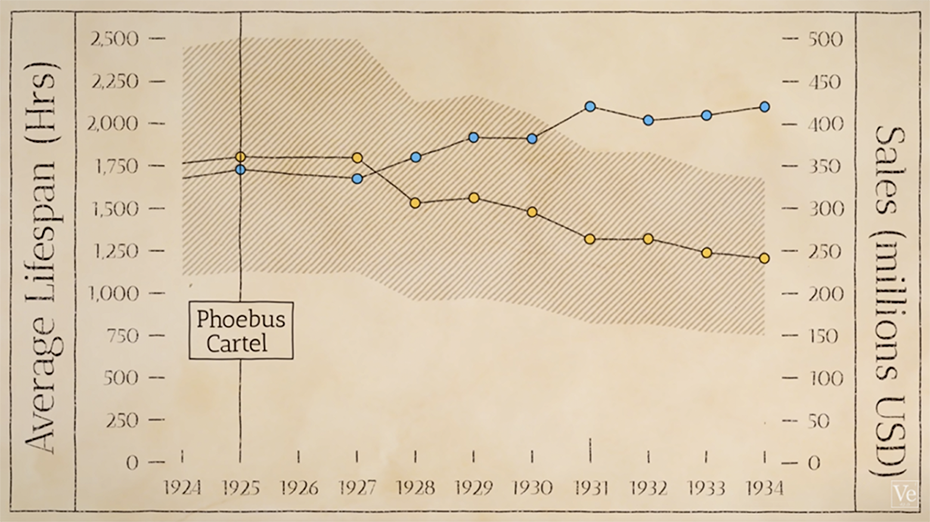Planned obsolescence as an idea for changing the world
Do you know what is planned obsolescence? I heard different explanations, but everything began for the bulbs. In 1879 Edison has built a bulb which could serve for 14 hours and before 1930 this time increased up to 2500 hours. In the first half of the century there were many small companies who was making them.

At the end of 1924, in Geneva a few large bulb producers like Philips, General Electric, Osram and some others created a Phoebus Cartel, which helped them to control a world’s bulb market by territory, so they absorbed all the smaller manufacturers. All of them had a huge fight with the bulb lifetime as occasionally sales started to decline — in 1923 Osram sold 23 million bulbs, but could only achieve a sales of 8 million bulbs during the following year.
So, the agreement was to limit the bulbs serving time by 1000 hours. If someones bulb was serving for a longer time, they paid a fine. The brightest engineering minds begun to create a better product using different materials, making contractors smaller and other degradations which helped to increase sales.
The cartel didn’t last long, but its methods were taken by many fabrics and the important reason was a 1929 depression, when 25% of the US population lost their jobs. So, it was necessary to produce more and consume more. People were scared by the fact that technological progress can leave them without a job.
The same story happened with General Motors, when their realised that making a similar model in a new color will lead to more sales and more frequent change of the cars. In 1955, they actually dropped this time from 5 to 2 years and invented a dynamic obsolescence. They motivated customers to change their cars every year.
I like to give you an example of Mercedes-Benz too…
Nowadays, in Europe and in the US, we have got a new laws of electronic repairability and even Apple allowed to repair their devices in 3rd party service centres, but will it lead to a better, long lasting product? No, it wouldn’t, because using software it is possible to make any product old or out-dated. It can be done not only using a software and new technologies, but also using high cost or repair and marketing — new colours, new features, more cool and etc. An environmental impact of this approach is unbelievably extreme.
Why would a manufacturer of some complex device like Apple get away from planned obsolescence? There should be aone important condition, where such manufacturer should be interested in a product which can serve for many many years.
A service model creates a need for more robust and serviceable things. May be it is a way for most of the industries to create less waste?
You remember some time ago Apple shifted their strategy from iPhone ever growing sales volumes to the fact that iPhone lasts for a long time, changing owners and they can make money selling Apps and services during whole drive lifecycle…
So, the agreement was to limit the bulbs serving time by 1000 hours. If someones bulb was serving for a longer time, they paid a fine. The brightest engineering minds begun to create a better product using different materials, making contractors smaller and other degradations which helped to increase sales.
The cartel didn’t last long, but its methods were taken by many fabrics and the important reason was a 1929 depression, when 25% of the US population lost their jobs. So, it was necessary to produce more and consume more. People were scared by the fact that technological progress can leave them without a job.
The same story happened with General Motors, when their realised that making a similar model in a new color will lead to more sales and more frequent change of the cars. In 1955, they actually dropped this time from 5 to 2 years and invented a dynamic obsolescence. They motivated customers to change their cars every year.
I like to give you an example of Mercedes-Benz too…
Nowadays, in Europe and in the US, we have got a new laws of electronic repairability and even Apple allowed to repair their devices in 3rd party service centres, but will it lead to a better, long lasting product? No, it wouldn’t, because using software it is possible to make any product old or out-dated. It can be done not only using a software and new technologies, but also using high cost or repair and marketing — new colours, new features, more cool and etc. An environmental impact of this approach is unbelievably extreme.
Why would a manufacturer of some complex device like Apple get away from planned obsolescence? There should be aone important condition, where such manufacturer should be interested in a product which can serve for many many years.
A service model creates a need for more robust and serviceable things. May be it is a way for most of the industries to create less waste?
You remember some time ago Apple shifted their strategy from iPhone ever growing sales volumes to the fact that iPhone lasts for a long time, changing owners and they can make money selling Apps and services during whole drive lifecycle…
